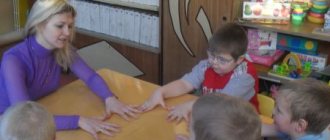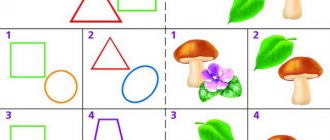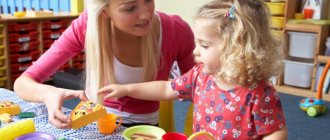Cognitive activities
Materials found: 143 Shown: 1 — 10
Integrated educational activity with children of middle preschool age on the topic “Zayushkina’s hut”
Program content. 1. Clarify knowledge about domestic and wild animals. 2. To form an idea of the meanings and functions of a traffic light. Instill traffic rules. 3. Strengthen the ability to determine the length of objects by...
FGT topic Furniture 2 junior group
“Rainbow” - topic “Furniture” Form ideas on the topic “Furniture” 2-ml. group To form an idea of the concept of “furniture”: • purpose; • Types of furniture; • Furniture parts; • What furniture is made from; • Methods of handling. Table,…
Three periods of autumn (compendium)
Summary of direct educational activities on the topic: “Three periods of autumn.” (preparatory group) Educational area “Cognition”: systematize children’s knowledge about autumn and autumn phenomena, consolidate ideas about...
Integrated lesson for children of senior preschool age using TRIZ “Oh, my bast shoes”
Goal: 1. Continue to develop the need for knowledge of the man-made world. 2. Improve knowledge about everyday objects (their color, shape, size, material, purpose. 3. Develop coherent speech. 4. Exercise in…
Summary of an open lesson with children of the preparatory group. NGO "Cognition", "Communication". on Topic: “The Journey of Water”
Lesson notes for the preparatory group Fr. O. “Cognition” “Communication” on the Topic: “The Journey of Water” Form of teaching: open lesson on cognitive and research activities of children. Number of children: subgroup Purpose:…
Summary of direct educational activities. "Autumn Fair"
Goals: to generate interest in the fair. Objectives: To summarize and systematize ideas about autumn according to the main, essential features, to consolidate knowledge about a person’s autumn preparations for winter in the garden. Activating the dictionary for...
Corrective lesson on the topic Clothes
Correctional lesson on the topic Clothes Goal: To develop the ability to differentiate clothes by season, to practice the use of pronouns, to use plural nouns in the nominative case in speech, to develop...
An educational activity with elements of work activity. “A hut is not red in its corners, but red in its pies”
Cognitive lesson with elements of work activity in the senior group. “A hut is not red in its corners - it is red in its pies” Goal: To introduce children to ancient household items and their purpose. Give children knowledge about what yeast is and...
Cognitive-speech lesson in the second junior group. "What grew in the garden"
Municipal budgetary preschool educational institution, child development center - kindergarten No. 19 “Joy” Cognitive - speech lesson in the second junior group TOPIC: “What grew in the garden” Prepared by: Marina Efimova...
Topic: “Journey to the Homeland of the Tomato”
Lushnikova M. V., teacher of the 2nd qualification category of the MKDOU D/s “Cherry”, Vargashi village.
Topic: “Journey to the homeland of the tomato.” Software tasks. Educational: to give children an idea of the plant’s need for light, ... Pages: ...
All sections
How to choose an online platform
There are many points that we recommend paying attention to when choosing online classes for comprehensive training:
- How old is the child?
- What are his strengths and weaknesses?
- What does he excel at and what are his leading abilities?
- What is the best time to study?
- Is the site safe?
- How much is it?
In our rating, we tried to take into account all of the above aspects. Let us immediately note that none of the listed sites spam advertisements or offer malicious external links, which ensures complete safety for children.
Games for children from 3 years old
Omelette. Cut out a circle the size of a plate from yellow colored paper and fold it in half. This is an omelette. We fill it with various little things (for example, old photographs, unexpected pictures, fragrant flower petals, raisins or coins for good luck). We serve the omelette on a plate and treat each other.
We empty our wallet. We pour all the coins from the wallet onto the table and sort them.
Let's hum. One of the players begins to hum a melody. Others should recognize her.
Birds fly high. Players drum their fingers on the edge of the table. Everyone takes turns naming an animal. If it flies, everyone raises their hands; if it doesn’t fly, they continue to drum. If someone makes a mistake, he gives away his forfeit.
We draw on fabric. We use textile paints to paint fabric, for example, an old T-shirt or a sheet.
Blind chicken. With our eyes closed, we try to walk from one room to another without hitting anything.
Laughing is prohibited. We are trying to make our friend laugh by telling him all sorts of nonsense. His job is to stay serious. Who will last longer?
Running with an “egg”. We put a ping pong ball on a teaspoon and run around the entire apartment, trying to keep the ball on the spoon.
Chatterboxes. Let's talk quickly. Who can do it longer?
We glue the collage. We tear newspaper or magazine pages into pieces. From this we glue a colored collage.
Who will blow next? We blow on the bottle caps so that they fly off as far as possible.
Blot pictures. Spray ink onto paper. Fold the paper with the blot inward, then unfold it again. Draw a picture from the prints.
We depict a snake . The more players, the better. We run around the apartment one after another, doing the same movements. The guide tells the players what they should do, such as crawl around the table or tumble around the room.
“Inflating” the pictures. Spray different paints on the paper, adding more water. Blowing through a straw produces multi-colored spots.
We dress up thematically. Prince and princess: We glue crowns from gold paper and put on a cloak. Astronaut: we make a helmet from a cardboard box, an oxygen tank from plastic bottles. Firefighter: colander as a helmet, dad’s jacket and belt, vacuum cleaner hose, etc.
Veterinary hospital. We put soft toys in bed and treat them: bandage them, give medications, measure the temperature, apply compresses, etc.
Let's keep our balance. With arms extended to the sides, we walk, like a tightrope walker, along the very edge of the carpet or a jump rope stretched out on the floor.
We score goals. Place the pan on the floor. Or we use bottles to mark gates on the floor. From a certain distance we throw ping-pong balls. Each hit earns a point.
Forfeit. We collect forfeits from the players. We ask others: “What should the player who owns this forfeit do?”
Let's play ice cream parlor . Fill a yogurt cup with fruit juice, yogurt, etc. and freeze it. Decorate the ice cream and serve.
Ping pong in the room. We sit on the floor. Using cardboard, hit the ping pong ball against the wall.
Games for children from 4 years old
We dress up the dolls. We make outfits for dolls from scraps. We fasten with ribbons or paper clips.
Throwing up a balloon. Throw a well-inflated balloon into the air. You need to push it up with your index finger, preventing it from falling.
We crawl on our backs. We lie on our backs and move around the room, trying not to touch anything.
We come up with hairstyles. We bring bows, barrettes and hair hoops. We give each other unusual, fantastic hairstyles.
Scratched pictures . We paint the surface of the paper with colored wax pencils, and on top with black paint. Using some object, we scratch various squiggles and lines so that the colored base appears through the black background.
We tell stories. One begins to tell a story. In the middle he is interrupted, and the next one must continue the story.
Drawing musical pictures. Let's turn on the music. On a piece of paper we draw colorful shapes that are associated with music.
Folding pictures. We draw a head on paper, bend it back and pass it on to someone else, who draws the stomach and arms and bends it back again. The next one finishes drawing the legs and feet. Expand and look at the drawing.
We count the points . We throw the dice one by one and count. The one who scores more points wins. You can draw a circle on paper with a felt-tip pen and throw peas or seeds over it from a small height. We only count those that are in the circle!
Let's guess the sounds. One player closes his eyes and tries to guess which of the other players just snored, grumbled or meowed.
Learning to jump. Jump on one leg for as long as possible. On two legs in place, “backing up”, etc.
Figure-rug. Using trousers, a shirt and boots, we lay out a figure on the floor. Draw a face of suitable size on paper, cut it out and apply it.
Finger caps. From the circles we glue our own pointed hat for each finger.
We flip the coin. Two players place a coin on the table and use their finger to shoot the coin from one to the other.
I see something that you don't see. We wish for some colored thing in the room. We name the color and ask you to guess this item.
We think quickly. One player quickly names a word. The other person should immediately say what came to his mind in this regard. Then we change roles.
Let's put on makeup. We paint our faces with mom’s cosmetics (or gouache, but we don’t do that for long!)
We make wishes about people. We look out the window. We come up with various stories about the people we see below.
Ghost game. Everyone wraps themselves in white sheets and circles around the apartment like ghosts, making terrifying sounds.
Making a picture book. Cut out pictures from a catalog or magazine. Glue it into a notebook and decorate the cover.
Let's play robbers. We hide several objects in the room that are in their usual places. Players returning to the room must guess what has disappeared and find it.
Magnet game. Place a magnet under the paper and a coin on the paper. Use a magnet to move the coin along the paper.
Drawings continued . Place a red dot in the center of the sheet of paper. We invite the next person to continue the drawing with a dot or line. Then the turn goes to the first player.
MUSICALITY, SENSORY, MOVEMENT
One of the main factors in the proper development of a preschooler at this age remains movement. He must move a lot. This increases his agility, endurance, coordination, develops muscles, and strengthens the skeleton. Therefore, the lesson program should have a lot of space for gymnastics, dancing, exercises, cycling, and all kinds of outdoor games. You can enroll your preschooler in some sports section.
And if motor activity is accompanied by well-chosen melodies, the child will also receive musical development. He will have an improved sense of rhythm, perception of fast and slow music, sad and cheerful.
Advice
At this age, a preschooler can be given to listen not only to children's melodies, but also to classical ones. He already has his favorite tunes, to which he begins to dance or hum.
Sensory perception is, first of all, the development of tactile sensitivity. The baby should have the opportunity to touch a variety of materials and textures: soft, hard, smooth, rough, fluffy, prickly, warm, cold. A good game is to recognize objects by touch without seeing them (for example, by taking them out of a bag).
Improving fine motor skills plays an important role. This helps improve all mental abilities: thinking, speech, memory. In addition, good fine motor skills prepare the hand for writing: the child will hold the pen correctly, the hand will strain and get tired less. Games with small objects and materials are good for this purpose: cubes, construction sets, mosaics, sand, cereals. This also includes finger games, tying shoelaces, fastening zippers, unscrewing corks, drawing, appliqués, and modeling.




